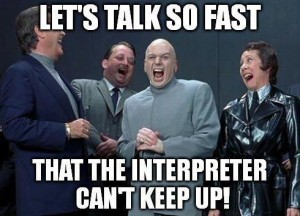 Listening to anyone speaking fast in a sworn proceeding is more of an event of animated questioning for most participants at the trial or deposition.
Listening to anyone speaking fast in a sworn proceeding is more of an event of animated questioning for most participants at the trial or deposition.
Unless you are the interpreter or the court reporter.
Court interpreters are sworn to transmit the question and the response word for word, accurately and completely. So we develop listening, note taking and responsiveness analysis skills. Here are a few tips on identifying and rendering the complete and identical sounding statement of the warp speed speaker in compliance with your oath.
The attorney and the witness have a higher probability to speak super quickly during a Q&A process. In trial, Judges pick up speed while reading out loud the written instructions or the charge to the jury. Almost everyone speaks faster than normal when reading written evidence into the record.
TIP: Ask for a copy of the document to sight translate simultaneously, in trial if there is no screen displaying the document or during a deposition .
The attorney will respond quickly to evidence mentioned by a witness that is uniquely positive or negative impact on their case. If positive, they will want the witness to stay on that topic so they will quickly add related questions. If negative, they will want the witness to go no further on that topic and they will change the topic altogether. In both situations they will accentuate the words in tone and volume that pertain to their chosen emphasized topic.
TIP: In your taking, jot down the accentuated words, since they will possibly be repeated by the questioning attorney for whom that is a valuable topic. And if one side wants the subject matter changed, the opposing counsel may zero in on that subject during cross.
Witnesses launch into hurried responses when triggered by something they feel strongly about. Their attorney may want that emotion displayed for the jury or on the deposition record, so we interpreters need to perfect our skills as much as possible before resorting to asking for intervention from the judge (or the questioning attorney (deposition).
Some triggers are obvious in the pointed, aggressive wording of the question, others are unknown to the interpreter.
TIP: We ignore the impact of the question or the response and focus on the content.
An animated emotional response has peaks of loudness, words that are run together, repeated points and sometimes stammering if the witness is flustered. We are supposed to render the same tone and style of the speaker in our interpretation.
TIP: Take notes while the witness responds to allow the witness to respond completely without interruption. Speed up your note taking with symbols and abbreviations.
TIP: Circle the loud words or phrases. ( I reserve underlining for topics frequently repeated in a question.)
TIP: Separate the words that were run together when spoken or you won’t be able to read your own notes. But encapsulate from end to end them with an underlining arrow or brackets to remind you to render them in a run together fashion.
TIP: Number the repeated points and the words that are stammered so that you repeat them just as many times as they were originally spoken. For example He turned left⁴
Have an evacuation plan. Know your limits by shadowing with a recorded lecture or television audio. Be prepared to notify the Judge, on the record and in the third person, that the witness is speaking too fast and is impeding your ability to render an accurate interpretation. Normally the Judge will advise the witness to slow down. Frankly, this instruction rarely sticks. If necessary, tell the Judge that you respectfully request that the witness be asked to break up their response into 3 or four sentences at a time.
TIP : Remember if you or the attorney interrupts the witness, that you have to interpret every word spoken for the record, even if it is an incomplete sentence.